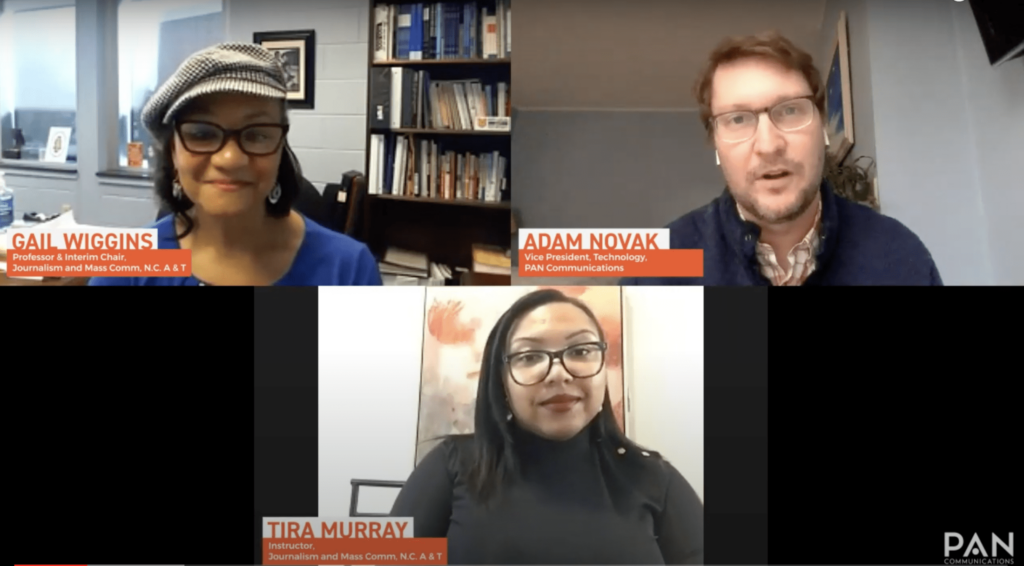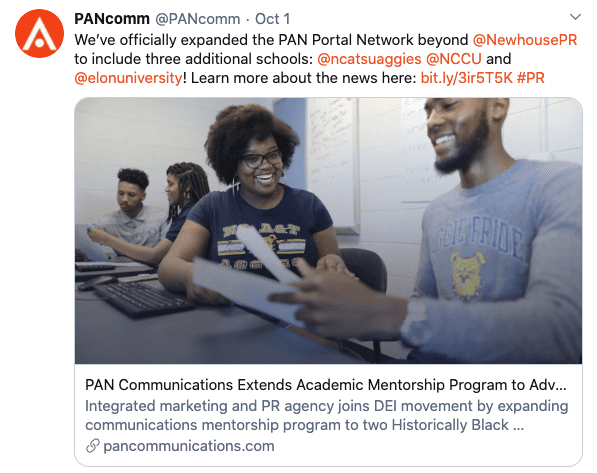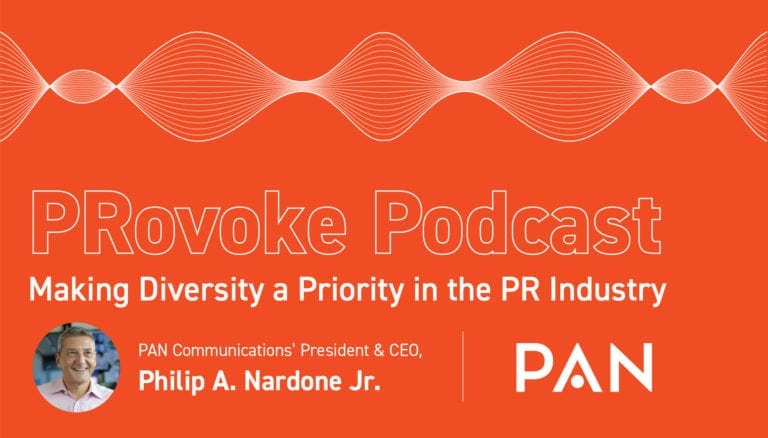Last fall, our agency announced the extension of the PAN Portal Program to three new schools, including North Carolina A&T, North Carolina Central, and Elon University. As a result of these efforts, our agency has begun to have important conversations within the BIPOC community about how to bring diversity, equity and inclusion to the communications industry.
One of those conversations was led by Adam Novak, a Vice President at PAN, who played a significant role in the initial launch of the program, as well as the expansion to these new schools. Adam interviewed Gail Wiggins, Interim Chair of Journalism and Mass Communication at NCA&T, and Tira Murray, a Communications Professor at NCA&T. Their discussion touches upon how the NCA&T communications program has evolved, what challenges students are facing post-grad today, and what PR agencies can do to help extend career opportunities to students at Historically Black Colleges and Universities (HBCUs).
Watch the video or read the transcript below to learn about the importance of diversity in the PR industry.
Adam: Hi, everyone. My name’s Adam Novak. I’m a technology vice president here at PAN, and just last semester we actually extended our PAN Portal program. For those of you who are not familiar with the program, it’s basically a one-on-one mentorship program with graduating seniors in the PR profession. This semester we did something that we haven’t done before. We extended our partnership to three schools, one of which is North Carolina A&T University. We’re especially proud of this partnership because we’re working now with the HBCU community to generate additional opportunities in our profession and grow representation, which is something that’s very important to us here at PAN.
As part of a discussion around our partnership and academia and professional development, I’m joined by two people from North Carolina A&T. I have Gail Wiggins, who’s the interim chair of journalism and mass communication, and I also have Tira Murray, who’s a communications instructor and a professor that we worked with on our first batch of students. Thank you both for joining me.
Talk to me a little bit about the public relations program at A&T. What areas are your students most interested in after they graduate?
Gail: Our public relations program at North Carolina A&T is designed to train students for careers in the public relations profession. A number of the students gravitate to corporations, government, nonprofit agencies, as well as entertainment and sports. But we do see quite a number of them working for corporations.
Adam: How has the public relations curriculum evolved over the last several years, and how has your school changed its courses to reflect those changes?
Gail: We have integrated a number of new courses in our program, as well as a few collaborations with other departments here at the university. Some of those new integrations include business courses, entrepreneurship, digital media, and we’re also looking at integrating more advertising and marketing courses within the curriculum.
Adam: How are your students faring in the current PR job market?
Tira: Our students are very strategic, but in a good way. They always have a backup plan. So, for example, if they were very headstrong on working in an agency, some have found themselves working in either government now or even being a part of a strategy team for political action committees. That has worked out really well for some of our students. Others have taken government positions such as social media managers or PR managers for local or small communities. So, I believe that they’re doing quite well in this time.
Adam: What are you finding that employers are interested in when they’re looking for students coming out of your program?
Tira: For our students, what I’ve noticed the most are these top three things, which are your work style, your knowledge of current software, and writing abilities. But with work style, seeing if the student can work independently, I’ve noticed that even with our interns, their site will specifically want them to have independent work that they can do at home, especially during this climate, or to see if they can work independently and then come together to do group work.
“Seeing if the student can work independently, I’ve noticed that even with our interns, their site will specifically want them to have independent work that they can do at home, especially during this climate, or to see if they can work independently and then come together to do group work.”
With software, this goes along the lines of analytics for social media and just for site viewership. Then along with CMS, if their website is attractive for viewers, and then also the editing portion, which is – can they edit videos? Can they edit pictures? Then, clearly, the last one with the writing abilities, can they write for their demographic? Are they able to do that?
Adam: Gail, you’re finding that students are being very creative and resilient in terms of finding relevant experiences as well, right?
Gail: Yes, absolutely. Many of the organizations that are looking to hire our students, they are looking for those relevant types of experiences as well, whether they have worked at small public relation agencies or even working here at the university on campus with some of the university media relations programs, as well as within their own PR SSA chapter. All of these experiences, hard skills, soft skills, those communication skills are extremely relevant in the hiring process. Those types of experiences are what many of the organizations are looking for as well.
“Many of the organizations that are looking to hire our students, they are looking for those relevant types of experiences as well, whether they have worked at small public relation agencies or even working here at the university on campus with some of the university media relations programs, as well as within their own PR SSA chapter.”
Adam: How have e-portfolios played a role in supporting students throughout their job hunts?
Tira: E-portfolios are so essential. I light up when I talk about it because thinking of all the students’ work that they produce in, really, a max of three weeks is amazing. Their e-portfolios are so, so important, and not just the aesthetic of it – if it looks nice and if it’s pleasing – but the quality of the content that’s in there.
I often stress to students, “You should not be adding classwork, because classwork cannot get you a job.” This pressures them to go and produce content on their own, which – from a student who’s adding regular coursework versus content that they’ve produced outside of the class, it’s a complete difference. It’s a total 180 difference from the portfolios that you would be viewing. But employers, they are very appreciative when they look at a portfolio, because they see that the student has put the time in to create something that is personalized. It’s their truest form that they will get to view them as a candidate rather than actually seeing them in person.
Learn more about how we’ve expanded the PAN e-portfolio program.
Adam: Gail, this is really a confidence booster for students as well?
Gail: Yes, absolutely. This is such a great form in preparing our students for the real world, and when they’re able to showcase their best work, this is a good way of marketing and branding themselves, and it just boosts their confidence when they’re able to show their work to other industry professionals.
Adam: What can the broader PR community do to advance opportunities from students from historically black colleges and universities?
Gail: The PR community organizations could actually work with universities or PR programs by participating in their career fair, in addition to those types of participations, to build a relationship. That’s what’s more meaningful to us. It’s building that relationship. In addition to attending the career fairs, we want them to come back, year after year after year, to get to know our students, our students to get to know the organization, because it’s very critical or very important to our students that they feel that they are wanted there and that they are a good fit for the organization.
“The PR community organizations could actually work with universities or PR programs by participating in their career fair, in addition to those types of participations, to build a relationship.”
Adam: That’s such a great point. I think that it’s a long-term relationship that’s generated over time, and it really shows investment from both sides, and the investment needs to be consistent. And that consistency hopefully will create a long-term pipeline of job placements between school and employer, and that doesn’t happen overnight.
Read more about our agency’s DEI commitment.
Tira: I believe the first step is identifying that there is a diversity and inclusion portion missing. Not a problem, because I’m a firm believer that problems can be solved, but I don’t think that that’s a problem. I think that it’s something that is missing. So, without identifying that, I don’t think that there will be much progression. But, when it’s identified, I believe that – not just saying “Well, we need one person who is from an HBCU, and we just need one person.” That is actually the term is called the token black person. I think that with organizations having just that one token black person does not represent every black person in America, nor globally. So, not just saying, “We want one person,” but “We need multiple,” and not just because of the movement that’s going on, because there needs to be something filled.
“The first step is identifying that there is a diversity and inclusion portion missing. Not a problem, because I’m a firm believer that problems can be solved, but I don’t think that that’s a problem. I think that it’s something that is missing.”
Really reading between the lines of that, that in order for this to happen, there has to be a continuation. It cannot just be one person to open the door and we wait five more years for the next Black person or the next Latino person. It has to be continuous. But even with that, I read an article not too long ago that said that somebody who is Caucasian with tattoos is considered diverse. So, we have to really understand what we’re looking for in diversity. Are we looking for someone who is ethnically different or who looks different? And how do we address that, and will that be addressed?
Adam: Absolutely, and I think that diversity comes in many different forms, but the fact of the matter is, without any consistency and without any sort of reinforcement, just filling the positions does not actively address the root of the problem, by any stretch.
What would you both recommend for someone who wanted to get more involved in the communications department at an HBCU? Somebody who genuinely has an interest in sort of building a better relationship. What are some of the ways that other communications professionals can get involved and generate greater employment opportunities for your students?
“Without any consistency and without any sort of reinforcement, just filling the positions does not actively address the root of the problem, by any stretch.”
Gail: I honestly believe that what you’re currently doing at PAN Communications, that that has been extremely effective in our department, and we want to continue those types of relationships. Being actively involved with the students, also bringing in new programs such as – this was our very first time knowing about the PAN Communication program. That has certainly been extremely beneficial.
But also, the mentoring piece, again, continuing to work with our students, master classes – I’m thinking of a number of things that have worked in the past. But I think the bottom line is that the more you get to know our students and the more our students get to know you, that we can become that pipeline and be extremely reflective of diversity as it relates to the community that we serve.
Adam: Well, on behalf of our entire PAN Portal team, we sincerely appreciate your partnership, and we appreciate your work with us, and we’ve really enjoyed getting to know your students, hearing about their career aspirations, hearing about their dreams in the field, and it’s just been a wonderful experience so far. Again, we feel so fortunate to be affiliated with you guys, and we very much appreciate our partnership.
I think I speak for everybody at PAN when I say that we sincerely appreciate your partnership, and we’ve really enjoyed getting to know your students over the past semester, hearing about their career aspirations, and working with them to grow their interest and experience in the field. And we sincerely appreciate your partnership and your work alongside us to better build this program, and we’re looking forward to many more semesters and, hopefully, a lot more employment opportunities from your students in the agency field. So, thank you both for your time again.





